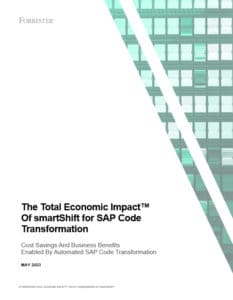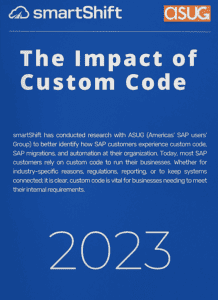

Jagdish Sahasrabudhe
Chief Technology Officer, smartShift
I’ve talked about the what and why. Now it’s time for the how of Clean Core. How can you get started, how smartShift can help you.
The concept of Clean Core includes elements of data, interfaces/integration, and business processes. In this blog, I will focus on the steps taken towards a Clean Core from purely a code perspective. This begins with gaining deep visibility into your current custom code. This means thoroughly analyzing your entire codebase, understanding how each custom object interacts with application modules, and identifying areas of priority to transform. You’ll want to base your transformation on data-driven insights so you can confidently address challenges and plan effectively. Understanding potential issues before starting your transformation ensures greater success. Remember, what you don’t know can hold you back—and that’s where smartShift can help you.
smartShift has believed in Clean Core for many years. Our solution has been developed through years of working with many of SAP’s largest customers and is built on automation and AI and lots of experience. It’s a proven solution many have already used. So, what does smartShift offer that others don’t? smartShift Clean Core X-Ray – it’s not only a solution, but prescriptive guidance on how to address Clean Core for you.
The Clean Core X-Ray solution by smartShift follows a comprehensive three-stage methodology designed to simplify and accelerate SAP Clean Core transformation.
The first stage focuses on a deep Repository Analysis where all custom objects, or “entry points”, are identified and classified. This process provides insights into the meta data, usage, and application classification, for each object in the custom code inventory list. This allows organizations to understand the entirety of their custom code, assess which customizations are essential and which can be retired or transformed.
In the second stage, Target Architecture is planned for each entry point. Based on the repository analysis, an appropriate future architecture for custom objects is designed – whether each should be retained and adapted, redesigned using modern SAP extensibility frameworks, or re-platformed to SAP’s cloud environments.
In the final stage, Realizations are performed. This includes code decommissioning, non-whitelisted API replacement with SAP-approved APIs, Table to CDS views and ABAP cloud syntax transformations and mapping classic to key user extensions.
Let’s explore Repository Analysis further – smartShift’s proprietary algorithms detect and catalog all custom-developed objects in the system resulting in an entry point report. Each entry point represents a distinct object or a group of objects that need to be evaluated for transformation. By classifying these objects, smartShift aligns them with the RICEFW framework (Reports, Interfaces, Conversions, Enhancements, Forms, Workflows), giving a structured view of the system’s custom code landscape.
This classification is crucial as it helps in determining the type of transformation required for each entry point. For example, reports may need to be streamlined, while interfaces may need to be re-architected using modern, whitelisted APIs. This step ensures that no custom code is overlooked during the clean core journey.
One of the most significant insights provided by Clean Core X-Ray is the usage analysis of entry points. Clean Core X-Ray determines whether custom objects are actively being used or are inactive and potentially obsolete. This holistic view of active and inactive entry points forms the foundation for the decommissioning process.
Inactive or unused objects are flagged for retirement, reducing the system’s overall complexity and eliminating technical debt. By focusing only on the code that is essential to current operations, organizations can streamline their SAP environments and reduce costs associated with maintaining redundant or unused customizations.
The repository analysis also includes the SAP Application Component Classification. This process involves mapping each custom entry point to its relevant SAP application component. smartShift’s advanced and proprietary algorithms not only assess the technical dependencies of each object but also examine critical object types and their relationships with SAP standard objects. This provides a clear view of how custom code interacts with the broader SAP code “ecosystem” and helps in making intelligent decisions about which components need re-architecting or decommissioning.
Clean Core X-Ray Repository Analysis
smartShift has made it easy for you to get started on Clean Core with our three step methodology. Let’s run a Clean Core X-Ray on your custom code to get you going. You can request your analysis here —>
SAP Clean Core: Opportunities and Challenges of the New Clean SAP World.
Want to learn more? Watch the replay of our ASUG Webcast with our CEO, Derek Oats. –> Watch the replay here.
The concept of “SAP Clean Core” promises a way out of slow and costly release cycles. SAP innovations can be adapted more quickly and the entire system becomes more agile. However, the path to a clean core can be rocky, especially in the case of mature, customized SAP landscapes. Pragmatism is required here.
Find out more about how smartShift can help you reach a Clean Core much faster and with less risk.
Key Takeaways:
✅ Discover the concept of clean core.
✅ Understand the challenges and opportunities of custom code.
✅ Explore the benefits of automation versus traditional transformation approaches.

Forrester TEI Report
See how smartShift solutions deliver 253% ROI for some of the world’s largest and most innovative SAP customers.
Discover how 177 SAP customers addressed custom code issues and where they found opportunities to improve.
The most effective way to handle SAP custom code?
Try our free Rapid Code Analysis. We’ll analyze and uncover every single issue.
Share This Article


